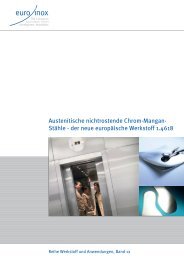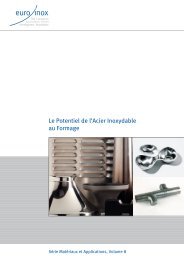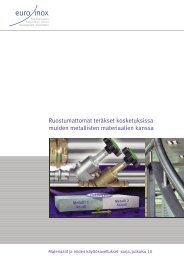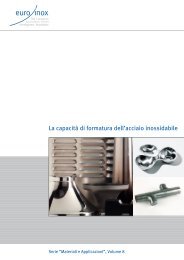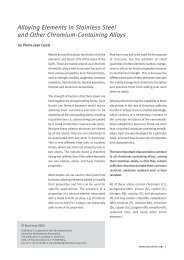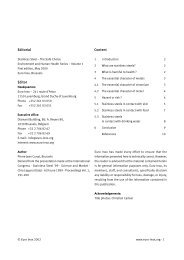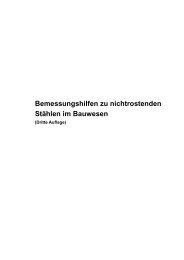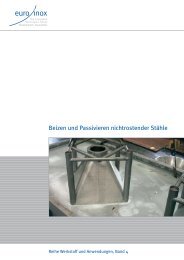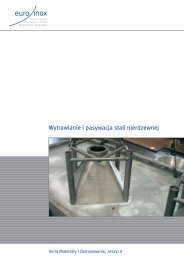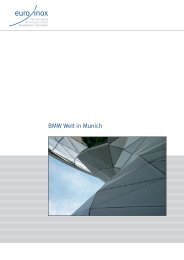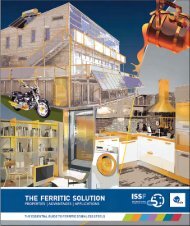Innovative Stainless Steel Applications in transport ... - Euro Inox
Innovative Stainless Steel Applications in transport ... - Euro Inox
Innovative Stainless Steel Applications in transport ... - Euro Inox
You also want an ePaper? Increase the reach of your titles
YUMPU automatically turns print PDFs into web optimized ePapers that Google loves.
(a) (b) (c)<br />
Figure 65. (a) Deflection of buckled members A, C and E, (b) deflection of side members J, K, L<br />
and M def<strong>in</strong>ed as deflection = b – a, (c) height of deformed cross-section ends Bfront and Dfront.<br />
Table 37. Rank<strong>in</strong>g of the test frames: crash performance with respect to different mean<br />
dimensional changes as described <strong>in</strong> Figure 65, start<strong>in</strong>g with the lowest (i.e. best) value (BUS p.<br />
174). The frame member codes are shown <strong>in</strong> Figure 64.<br />
Rank Deflection Deflection of side Height of deformed Mean total crack<br />
members cross-section length <strong>in</strong><br />
A, C, E J, M, K, L B, D weld l<strong>in</strong>es<br />
+5 °C -20 °C +5 °C -20 °C +5 °C -20 °C +5 °C -20 °C<br />
1 304SP 304SP 304SP 304SP 304SP 304SP 1.4301 1.4003<br />
2 16-7Mn 16-7Mn 16-7Mn 16-7Mn 16-7Mn 1.4301 1.4003 1.4301<br />
3 1.4003 1.4301 1.4003 1.4301 1.4003 16-7Mn 16-7Mn 304SP<br />
4 1.4301 1.4003 1.4301 1.4003 1.4301 1.4003 304SP 16-7Mn<br />
5 St37 St37 St37 St37 St37 St37 St37 St37<br />
The total crack length <strong>in</strong> the weld<strong>in</strong>g l<strong>in</strong>es is almost equal (±2 mm) for 1.4301, 1.4003<br />
and St37 at both +5 °C and –20 °C. However, the crack length for 16-7Mn and 304SP<br />
decreases drastically with temperature. Total crack length decreases from 40 mm to<br />
15 mm for both materials at temperatures of +5 and –20 °C, respectively.<br />
Weld-l<strong>in</strong>e crack<strong>in</strong>g occurred at the nodes where the frame members are welded<br />
together. In all frames, deformation at member-ends Mtop and Jtop is absorbed by<br />
deformation of the open tube-section ends Bfront and Dfront. In the left and right nodes of<br />
member A, energy was absorbed by the cross-sectional deformation of tubes B and D.<br />
5.3.4 Panel compression and crash test<strong>in</strong>g<br />
Quasi-static compression tests were carried out on panel sections, to determ<strong>in</strong>e buckl<strong>in</strong>g<br />
strength and buckl<strong>in</strong>g mode, as background <strong>in</strong>formation for dynamic crash of the<br />
panels. In this case, panel deformation consists of two parts: below the buckl<strong>in</strong>g load,<br />
very large forces but small axial displacements result <strong>in</strong> low elastic-energy absorb<strong>in</strong>g<br />
capacity. Here, the only relevant parameters are the modulus of elasticity, moment of<br />
<strong>in</strong>ertia of the cross-section and panel length. After the buckl<strong>in</strong>g load (post-buckl<strong>in</strong>g), the<br />
b<br />
a<br />
105



